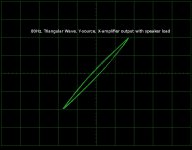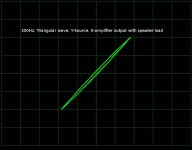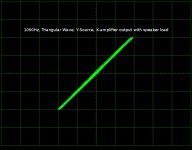Hi All,
I am a newbie in DIY world. Thanks to several interesting threads in this forum, I learned the importance of measuring and calibrating DIY equipment. As the first step of learning, I thought of measuring my present off-the-shelf amplifier. I installed software wave generator and oscilloscope on my laptop. Then connected output to amplifier's input and measured output across output terminals with speaker load connected. I got attached interesting graphs. These graphs have been plotted with the source waveform on Y-axis and amplifier output on X-axis. I did several measurements by varying frequency and using sine and triangular waves. The outputs were more or less same. I am attaching the outputs for triangular waves.
As you can see at lower frequencies I see a clear Elliptical shape. As the frequency is increased the ellipse goes thinner, eventually going flat. I have shown frequency response at 80Hz, 200Hz and 1KHz. 1KHz response isn't a straight line, it's a think set of several lines, which I believe could also be because of instabilities of the laptop output.
Could experts on this form help me understand these graphs? Does an elliptical graph imply a phase shift? If yes, I can conclude that my amplifier causes a phase shift at lower frequencies. The phase shift vanishes above 1KHz.
Thanks.
I am a newbie in DIY world. Thanks to several interesting threads in this forum, I learned the importance of measuring and calibrating DIY equipment. As the first step of learning, I thought of measuring my present off-the-shelf amplifier. I installed software wave generator and oscilloscope on my laptop. Then connected output to amplifier's input and measured output across output terminals with speaker load connected. I got attached interesting graphs. These graphs have been plotted with the source waveform on Y-axis and amplifier output on X-axis. I did several measurements by varying frequency and using sine and triangular waves. The outputs were more or less same. I am attaching the outputs for triangular waves.
As you can see at lower frequencies I see a clear Elliptical shape. As the frequency is increased the ellipse goes thinner, eventually going flat. I have shown frequency response at 80Hz, 200Hz and 1KHz. 1KHz response isn't a straight line, it's a think set of several lines, which I believe could also be because of instabilities of the laptop output.
Could experts on this form help me understand these graphs? Does an elliptical graph imply a phase shift? If yes, I can conclude that my amplifier causes a phase shift at lower frequencies. The phase shift vanishes above 1KHz.
Thanks.
Attachments
You are viewing the amplifier transfer function, although conventionally the input would be X and output Y. An ellipse means phase shift, as you say. This is normal at frequency extremes, both high and low. Phase shift becomes noticeable well before the gain drops off.
This test can show serious distortion, such as clipping or gross crossover distortion, but in a working amplifier it should not show very much which may be why people don't use it very much. Useful for debugging faults, but not for measuring normal function.
This test can show serious distortion, such as clipping or gross crossover distortion, but in a working amplifier it should not show very much which may be why people don't use it very much. Useful for debugging faults, but not for measuring normal function.
Thanks.
It's good that I can use this test to investigate faults when I build circuits. Are there any other similar useful tests?
I am now going to build a notch filter for room acoustic correction. I guess I should be good to go with this test and a multimeter. I'll create a separate thread for it.
It's good that I can use this test to investigate faults when I build circuits. Are there any other similar useful tests?
I am now going to build a notch filter for room acoustic correction. I guess I should be good to go with this test and a multimeter. I'll create a separate thread for it.
"...Are there any other similar useful tests? ..."
-------------------------------------------------
If you are interested in learning about audio tests and procedures, I recommend "Fundamentals of Modern Audio Measurement" and "The Audio Measurement Handbook"
Both are available for download at:
AP High Performance Audio Analyzer & Audio Test Instruments : Downloads
-------------------------------------------------
If you are interested in learning about audio tests and procedures, I recommend "Fundamentals of Modern Audio Measurement" and "The Audio Measurement Handbook"
Both are available for download at:
AP High Performance Audio Analyzer & Audio Test Instruments : Downloads
- Status
- Not open for further replies.


